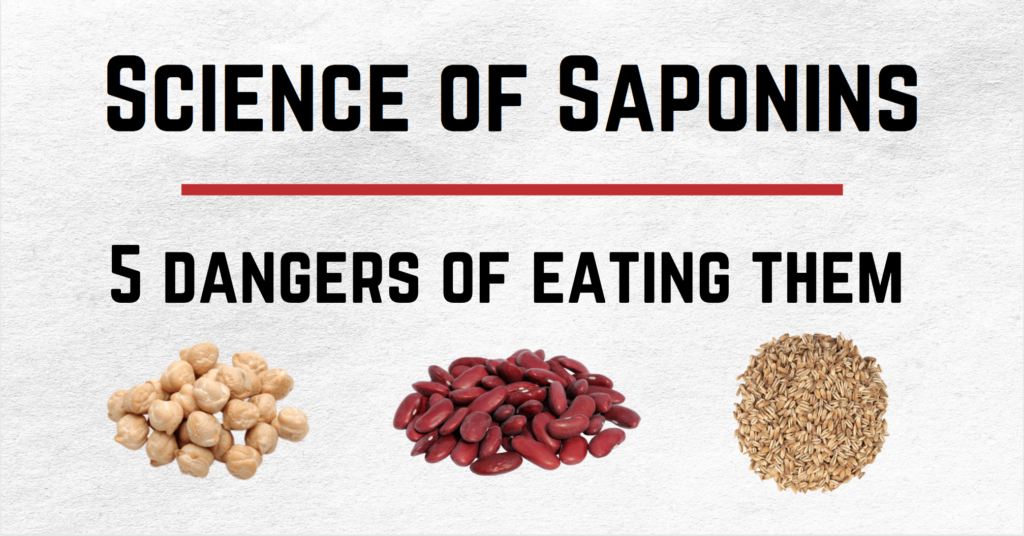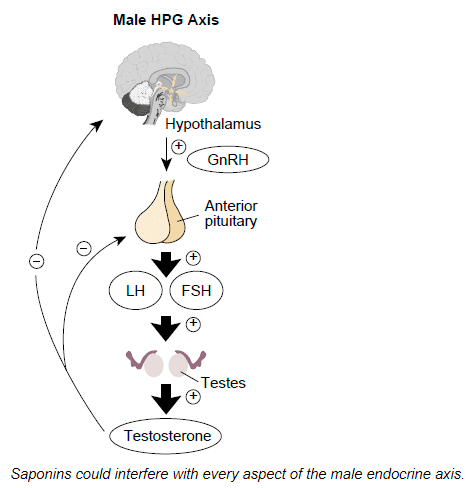
Want to hear something scary? What if I told you some of your favorite superfoods are actually hurting you.
Almost like finding out your doctor spends his free time as an axe murderer…
Turns out plants don’t want to be eaten. To defend themselves, they produce toxic booby traps. One of which is saponins.
Now you may need to sit down for this…
Quinoa, the pope of the church of superfoods, is loaded with these chemicals.
Saponins can
- Block nutrient absorption
- Damage metabolism
- Kill cells
Keep reading to learn the truth about saponins according to science, which foods are high in saponins, and 5 dangers of eating them.

5 Dangers of Eating Saponins
- Saponins are Antinutrients and Disrupt Fat Metabolism
- Saponins Increase Intestinal Permeability
- Saponins Cleave Cholesterol
- Saponins Disrupt Endocrine Function
- Saponins are Toxic to Cells
What Are Saponins?
Saponins…Not just a shorthand way to say hello to someone. “What’s saponin?”
Saponins are a class of bitter-tasting compounds that produce soap-like foam when added to water. Most saponins occur naturally in plants, but some are manmade for scientific or industrial purposes.
All saponins have a hydrophilic (water soluble) carbohydrate bonded to a lipophilic (fat soluble) triterpene or steroid structure. The hydrophilic and hydrophobic properties interact with the surface tension of water to create bubbles in aqueous solutions.

Like many plant compounds, saponins evolved as a defense system against herbivores and insects[*]. Unlike human beings, they don’t like being submerged in a bubble bath.

Are Saponins Healthy?
Overall, the effects of dietary saponins aren’t very well-studied. Some researchers believe they have medicinal effects or health benefits, but any such effects appear to be hormetic in nature.
Hormesis is a favorable biological response that sometimes occurs when cells or organisms are exposed to manageable amounts of toxins or stress.
According to the authors of a 2018 paper,
“Emerging evidence suggests that hormetic phytochemicals produced by environmentally stressed plants can activate the moderate cellular stress response mechanisms at a subtoxic level in humans, which may enhance tolerance against severe dysfunction or disease.”[*]
In other words, by taking in low levels of toxic compounds, you might make your cells stronger. As Nietzsche said “What doesn’t kill you makes you stronger…but quinoa still tastes like cardboard.”
The dose makes the poison. And unfortunately, no one really knows what the correct dose of saponins is for these effects.
Someone who eats saponin-rich foods every day could be well above the threshold for any theoretical beneficial hormetic effects. And if you are already unwell, they could easily make you sicker.
That’s why I recommend exercise, fasting, cold exposure, and other forms of hormesis instead.
They’re safer because you can control the dose and gauge the effects much more easily
Some studies also show that Ketones and BHB upregulate the same antioxidant pathways, without the side effects [*].
Even if saponins are beneficial from an antioxidant perspective, they have side effects. It’s like smoking a cigarette combined with quinoa, because it has antioxidants.
Keep reading to learn 5 reasons why eating saponin-rich plant foods is unwise.
Foods Highest In Saponins
Watch out for these foods saponin content
- Licorice root (22.2-32.3 grams per 100g)[*]
- Legumes, especially peanuts, soybeans (3.9-5.6 grams per 100g), and chickpeas (3.6-5 grams per 100g)[*][*]
- Quinoa (up to 0.73g per 100g)[*]
- Spinach (0.5g per 100g)[*][*]
- Oats (0.1-0.3g per 100g)[*][*]

And processing or cooking does not significantly lower saponin content[*].
While rinsing quinoa or other foods may remove a portion of saponins, this isn’t true of all foods that contain saponins, like spinach for example[*].
Some processed foods may even include elevated levels of saponins added during manufacturing[*][*].
Pro tip on how to reduce saponin content: Cook saponin containing foods in vegetable oils, then throw them in the trash.
This is why I recommend the carnivore diet. if you’re interested in a 30 day guide to getting started, make sure to sign up at the end of the article.
5 Reasons to Avoid Saponins
#1: Saponins are Antinutrients and Disrupt Fat Metabolism
Similar to oxalates, phytins, lectins, and tannins, saponins are antinutrients[*]. These jerks bully your cells and steal their nutrients.
Research shows that saponins in plant foods may interfere with the absorption and digestion of glucose, protein, and vitamins A, B12, D, and E[*][*][*].
They can also form protein complexes that have unknown effects when combined with proteins like casein from milk[*].
Not only that, saponins can disrupt the digestion of cholesterol and saturated fat.
Saponins form complexes with cholesterol that cause up to 44% of dietary cholesterol to be excreted rather than digested[*][*]. And in the case of saturated fats, they can decrease absorption by up to 87% by forming calcium-containing complexes[*].

They also inhibit pancreatic lipase which can cause oily diarrhea and liver failure[*][*]. The only people saponins benefit: the executives of Charmin toilet paper.
Vegetables are not this horcrux that solves all your problems. Turns out they can even make you fat.
Some saponins may even inhibit lipolysis (the release of free fatty acids) and hepatic gluconeogenesis, which could prevent your body from burning stored fat[*].
The mainstream medical paradigm considers antinutrients that disrupt cholesterol and fat metabolism “beneficial” because of the narrative that cholesterol and fat are responsible for heart disease and the obesity epidemic.
However, nothing could be further from the truth. You need cholesterol and saturated fat to make hormones and stay alive, and higher intake levels correlate to a healthier, longer life.
#2: Saponins Increase Intestinal Permeability
Along with preventing absorption of some nutrients, eating too many saponins can cause leaky gut.
According to the authors of a study published in the Journal of Nutrition,
“The results indicate that some saponins readily increase the permeability of the small intestinal mucosal cells, thereby inhibiting active nutrient transport, and facilitating the uptake of materials to which the gut would normally be impermeable.”[*]
Basically, increased permeability of your intestines can allow bacteria, metabolites, and small food molecules to “leak” into your bloodstream and cause autoimmune issues and inflammation[*]. Your gut, stops holding the door.

Think of your gut like an exclusive club. The bouncers are the single layer of epithelial cells. In line, there are both toxins — underrage and uncool kids — and nutrients — celebrities and fashionistas you want inside. When your gut bouncers reject the toxins, saponins beat them over the head and find their way in anyways.
The club turns from something cool, fun and exclusive to a drunk, under-age mosh pit. It’s a disaster for everyone.
Mouse studies of high doses of saponins demonstrate intestinal hemorrhage, erosion of mucosa, and damage to the small intestine, liver, and kidney[*].
Although it’s unlikely anyone eats enough saponins to cause hemorrhaging, some researchers think that elevated saponins in modern diets might be responsible for gut and immune issues[*].
“Leaky gut syndrome” may be responsible for rising rates of celiac disease, too[*].
#3: Saponins Cleave Cholesterol
Remember how saponins form complexes in your gut that prevent cholesterol from absorbing?
Saponins can also interfere with cholesterol in your cells and cell membranes[*]. All your cells contain cholesterol, and they require it for normal functioning[*].
In fact, scientists often use saponins to cleave cholesterol from cell membranes intentionally, to better examine them[*]. Instead of eating leftover quinoa, scientists put it in a test tube to conduct their tests. Okay, not actually. These scientists use chemically isolated saponins — but it’s the same exact chemical.
Plant saponins also have the ability to strip away phospholipids, another vital part of cells[*].
According to a 2013 peer-reviewed paper, “the general cytotoxicity of saponins is mainly dependent on their membrane toxicity and that the membrane toxicity might be caused by the loss of cholesterol from the cell membrane”[*].
Keep that in mind next time you hear someone talking about the benefits of “lowering your cholesterol” with plant compounds or drugs.

#4: Saponins Can Disrupt Endocrine Function
Saponins can disrupt male and female hormones in two different ways.
First of all, even though your cells can make cholesterol, you need adequate dietary cholesterol to sustain production of sex hormones[*][*]. And as we’ve already learned, saponins prevent your body from absorbing cholesterol.
Second, many saponins have a phytoestrogenic effect and may act as an endocrine disruptor[*].
In men, endocrine disruptors can reduce testosterone levels, lower sperm count, and cause feminization[*]. We all knew eating quinoa was lame, but this takes it to a whole new level.

And research links endocrine disruption in women to higher rates of breast cancer, infertility, and children with birth defects[*].
Finally, children may be more susceptible to endocrine disruption because their brains and organs are still in development[*][*].
That’s why I recommend that everyone, but especially kids, avoid saponins. Why take the risk?
#5: Saponins are Toxic to Cells
We’ve already covered the fact that saponins can cleave cholesterol from cells and increase gut permeability.
However, the cytotoxicity (cellular toxicity) of saponins extends beyond those effects.
While some scientists think it could make saponins useful for treating cancer, cytotoxicity is a double-edged sword (at best)[*].
For example, saponins remove the cell membrane from erythrocytes and destroy red blood cells[*].
Saponins are a one-two punch. They first damage your gut junctions and allow molecules into your bloodstream. Then once inside, they destroy your cellular integrity.
In vitro studies also show that saponins can damage and dissolve the endothelium (delicate, single-cell lining) of blood vessels[*].
Do people typically eat enough saponins to cause these effects?
No one knows for sure, but if you eat a standard vegan cocktail of soy, chickpeas, quinoa, or take saponin supplements like ginseng or licorice root, you could be getting several grams of saponins each day.
Studies show that saponins cleave cell membranes in concentrations of micrograms per milliliter [*]. Do you really want to unleash these toxic termites into your bloodstream?
Last but not least, plant saponins are also genotoxic, meaning they cause DNA damage and interfere with cell replication[*].
According to a 2015 study, a triterpenoid saponin caused DNA damage in concentrations as low as 5 micrograms per milliliter[*]. That translates to human serum levels as low as a few milligrams of saponins.
Essentially, the evidence shows that saponins are likely to cause problems no matter where they end up in your body.
Final Thoughts
Are saponins helpful or harmful?
For the most part, they’re harmful.
Most of the purported health benefits involve lowering blood glucose, insulin levels, cholesterol levels, or triglycerides[*]. But if you eat a healthy diet to begin with, you don’t have to worry about any of those things.
Perhaps in the future, someone will discover that saponins can help cancer patients. But you wouldn’t chow down on chemotherapy drugs at every meal to prevent cancer, would you?
Bottom line: instead of taking “plant medicine” to heal the effects of a toxic diet, try eating a diet that isn’t toxic.
Source: https://carnivoreaurelius.com/saponins/